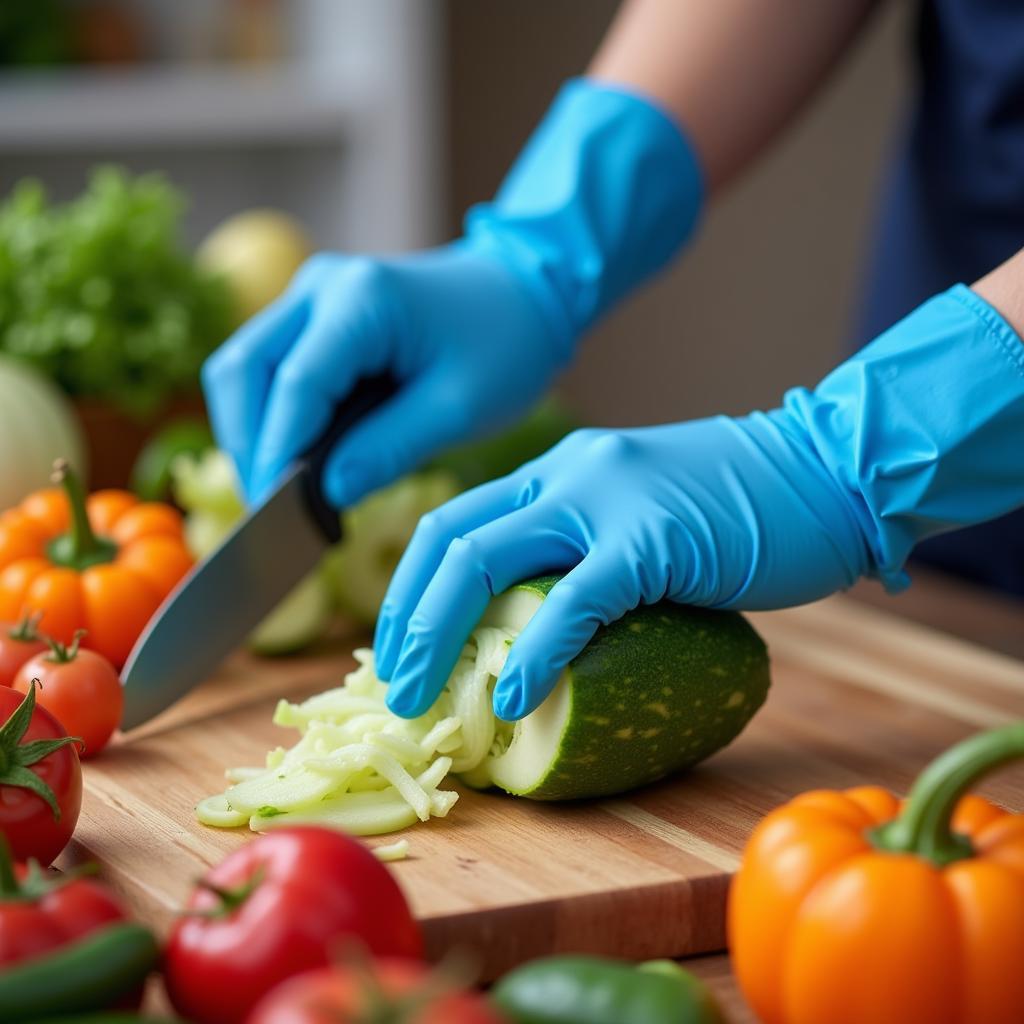Food safety is paramount, whether you’re a seasoned chef or a home cook whipping up a quick meal. While we often focus on fresh ingredients and proper cooking temperatures, one crucial aspect of food safety sometimes gets overlooked: hand hygiene. That’s where Nitrile Gloves For Food come into play. These gloves act as a barrier, preventing the spread of bacteria and ensuring your culinary creations are as safe as they are delicious.
Why Choose Nitrile Gloves for Food Handling?
You might wonder, “Are nitrile gloves for food really necessary?” The answer is a resounding yes! Here’s why:
- Superior Protection: Nitrile gloves provide a robust shield against bacteria, viruses, and other contaminants that can linger on your hands.
- Durability and Strength: Unlike latex gloves that can easily tear, nitrile gloves are puncture-resistant and can withstand the rigors of food prep, from handling sharp knives to mixing acidic ingredients.
- Food-Safe Material: Nitrile is a synthetic rubber that’s free from latex proteins, making it a safe choice for individuals with latex allergies.
- Versatile and Comfortable: Nitrile gloves come in various sizes to ensure a snug fit and offer excellent tactile sensitivity, allowing you to maintain dexterity while chopping, slicing, and plating.
 Food prep with nitrile gloves
Food prep with nitrile gloves
Exploring the Benefits: When to Use Nitrile Gloves for Food
From prepping raw meat to assembling delicate desserts, there are numerous instances where nitrile gloves are indispensable in the kitchen:
- Handling Raw Meat, Poultry, and Fish: These raw ingredients often harbor bacteria that can cause foodborne illnesses. Wearing nitrile gloves minimizes cross-contamination risks.
- Working with Allergenic Foods: If you’re handling allergens like nuts, dairy, or gluten, wearing gloves prevents cross-contact and protects those with sensitivities.
- Food Service and Handling: In restaurants and food stalls, nitrile gloves are crucial for maintaining hygiene standards and ensuring customer safety.
- Large-Scale Food Production: When preparing food for a crowd, nitrile gloves are essential for preventing the spread of germs and maintaining a sanitary environment.
Choosing the Right Nitrile Gloves: Factors to Consider
Not all nitrile gloves are created equal. Consider these factors when making your selection:
- Thickness and Durability: Thicker gloves offer greater protection against punctures and tears, while thinner gloves provide better dexterity for delicate tasks.
- Size and Fit: Choose gloves that fit snugly but comfortably to ensure maximum dexterity and prevent slipping.
- Color: While blue nitrile gloves are standard in food handling, other colors are available. Some food facilities use color-coding systems to prevent cross-contamination between different food types.
- Powder-Free vs. Powdered: Powder-free gloves eliminate the risk of powder contamination in food, while powdered gloves are easier to put on and take off.
Nitrile Gloves vs. the Competition: Why They Reign Supreme
You might encounter other glove options like vinyl or latex, but nitrile gloves have distinct advantages:
- Vinyl Gloves: While more economical, vinyl vs nitrile gloves for food often lack the durability and puncture resistance of nitrile, making them less suitable for tasks involving sharp objects.
- Latex Gloves: Latex gloves offer good dexterity but can trigger allergic reactions in some individuals. Nitrile gloves are a safer alternative for those with latex sensitivities.
FAQs About Nitrile Gloves for Food
1. Are blue nitrile gloves food safe?
Yes, are blue nitrile gloves food safe are generally safe for food contact. They are made from FDA-approved materials specifically designed for food handling.
2. Can you reuse nitrile gloves for food prep?
It’s not recommended to reuse nitrile gloves. They are designed for single use to prevent cross-contamination.
3. What are the best gloves for preparing food?
Gloves for preparing food should be durable, puncture-resistant, and made from food-safe materials like nitrile.
4. What kind of gloves are used for hot food?
While nitrile gloves offer some heat resistance, it’s crucial to use hot gloves for food specifically designed for high temperatures when handling hot food items.
5. Can I wash and reuse nitrile gloves?
Washing and reusing nitrile gloves can compromise their integrity and increase the risk of contamination. It’s always best to use a fresh pair for each food handling task.
Making Food Safety a Priority with Nitrile Gloves
In the realm of food preparation, prioritizing safety is non-negotiable. Nitrile gloves provide a simple yet effective solution to elevate your hygiene standards, whether you’re a seasoned chef or a home cook passionate about creating delicious and safe meals. By incorporating nitrile gloves into your culinary routine, you add an extra layer of protection, ensuring that every dish you prepare is as safe as it is scrumptious. Remember, food safety starts with clean hands – and nitrile gloves are your trusty sidekick in maintaining a hygienic kitchen environment.
Need help choosing the right gloves for your needs? Contact us at Phone Number: 02437655121, Email: minacones@gmail.com or visit us at 3PGH+8R9, ĐT70A, thôn Trung, Bắc Từ Liêm, Hà Nội, Việt Nam. Our dedicated customer support team is available 24/7 to assist you.